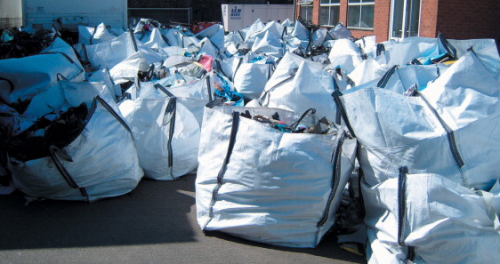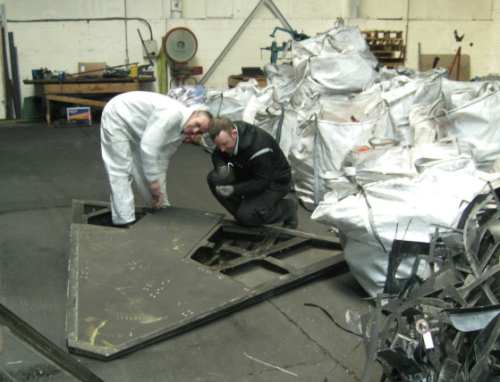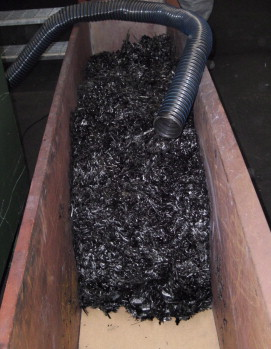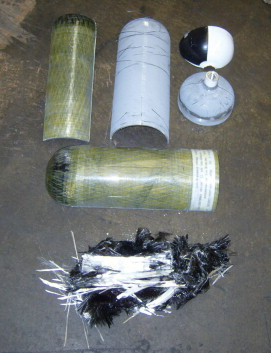



Carbon composites bring a unique combination of low-weight, strength and stiffness to load-bearing structures used in a range of land, sea, air and space vehicles as well as many industrial, consumer and sports goods. But no sooner has the material become firmly established than industrial society is having to face a downside, the issue of end-of-life disposal.
Some of the first generation of airliners to have substantial carbon content will soon reach the ends of their 25-30 year service lives and from now on growing numbers of used aircraft will be going to the breakers, generating tonnes of used carbon composite. Imagine the flow after another 25 years when currently new 50% carbon airliners like the Boeing 787 and Airbus A350 start to come up for disposal. Then factor in all the material from end-of-life wind turbine blades (the largest blades will have substantial carbon content), trains, road vehicles, boats, sporting goods etc, and it is clear that disposal of carbon, the most challenging ‘regular’ composite in this respect, will be a big issue. (Currently the world produces an estimated 25 000-30 000 tonnes of carbon fibre each year.)
Companies, including airframers and other original equipment manufacturers (OEMs), are seeking alternatives to present landfill and incineration practices. There are even signs of an emerging disposal supply chain. One UK company which, though small currently, is seen as a key player in this regard is Milled Carbon Ltd. Managing Director John Davidson has a mission to show that recycling carbon composites is both feasible and economically viable, while liberating the value locked up in every kilogramme of end-of-life carbon fibre composite.
A first glimpse of the company's unprepossessing looking facility at West Bromwich, near Birmingham, UK, provides immediate insight into the carbon recycling challenge. Outside are piles of ‘black junk’ which, on closer inspection, turn out to be panels from newly out-of-production supercars, moulds and fixtures no longer required by aircraft manufacturers, pipes, cylindrical pressure vessels, a performance yacht hull mould, bicycle frames, rolls of manufacturing-reject material, various cured offcuts and uncured prepreg scrap, test items – in fact a huge variety of unwanted carbon waste. Moments later I am shown a bag of granulated carbon and later I witness the production of a tow of fine, clean carbon fibre, both recycled outputs being destined for re-use in new carbon composite products.
“All sorts of manufacturers of carbon composite items are happy to bring their waste here,” John Davidson points out. “We offer them a disposal service for both cured and uncured composite and the fact that the material is then recycled gives them a marketing plus by strengthening their environmental credentials. They clearly prefer this to having to send their unwanted material, via normal commercial waste channels, to holes in the ground.”
The West Bromwich facility is a pilot plant, established to develop and demonstrate recycling techniques and to determine business viability. Milled Carbon Ltd was formed in 2003, though the business had earlier roots when a private entrepreneur had started to investigate the possibilities. Shortly after the company was formed Davidson, who had a 20-year track record with carbon, including having helped set up SGL Technic's previous carbon manufacturing facility in Scotland, was brought in to head up the company and develop its business. In turn, Davidson recruited long-time associate Stephen Johnson as Operations Director to take charge of shop floor activities. The company is still privately owned and funded, principally by the original shareholder already mentioned with a shareholding of 80%. The remaining 20% is held by John Davidson. In the next stage of its evolution, the company is due this autumn to move to a new plant, also near Birmingham, and recommence work with a new, full-scale production facility.
Process
The company stresses that it can process any form of carbon composite scrap whether cured or uncured, thermoset or thermoplastic. Scrap items up to 2 m wide, 250 mm high and 25 mm thick can be processed, including composite sandwich structures with honeycomb core. Uncured composite production waste, from UD tape to complex wovens, can be handled, as can a range of resins – typically epoxies, but sometimes bismaleimides, phenolics and others.
At first, composite fabricators were sending in just their manufacturing waste, mainly comprising thin sheet offcuts, ends of rolls etc, but later structural parts began to arrive too. Generally, customers carry out a prior identification and separation of composite from other waste and are encouraged to tell the recycling company whether particular items are thermoset or thermoplastic and whether they include fire-retardant additives. This knowledge helps determine process suitability and parameters.
Central to Milled Carbon's operations is pyrolysis, a thermal process for separating carbon fibres from resin. Heating input material to a high temperature in a reduced-oxygen atmosphere melts the resin, which drops away from the fibres along with any filler and other associated materials. Tests by Boeing and other organisations have established that the recycled fibres retain 80-90% of the mechanical properties of the original virgin material. The recycled fibres are also reported to be clean and free of binder and even the sizing applied by the original fibre manufacturer.
“Our fibres are pure carbon,” Davidson emphasises. “The fact that they are very clean, with even the sizing removed, means that users can get better chemical adhesion than virgin material can deliver. Taking the sizing off unlocks the natural chemical activity of which the bare fibres are capable.”
Davidson and Johnson originally set up their pilot plant by purchasing a pre-used sintering oven, which they then modified and refined to suit their application. Electric elements can heat the interior to almost 900°C, though 600°C is more normal in practice. Setting up the plant and getting it to run satisfactorily took 18 months.
Initially, the production team was recycling material in batches but the discontinuities resulting from the need to constantly stop and restart the process prompted the realisation that a continuous process would be more efficient. Accordingly, a heat tolerant chrome-molybdenum conveyor was installed so that continuous throughput could be accomplished, and oven characteristics were modified to suit.
A number of processes operate in conjunction with the pyrolysis line. An initial operation is to reduce incoming cured composite scrap to manageable pieces. This currently labour intensive stage is undertaken by operatives equipped with various grinders, band saws and cutters. Carbon blunts cutting tools rapidly and transitioning to diamond-tipped cutters has proved a worthwhile investment.
Carbon fibres recycled via the pyrolysis process can be supplied as tow, or they can be chopped and then in a further optional stage, reduced to smaller particle sizes still by milling. For the chopping-only option, a chopping machine is set to produce fibre lengths of 3-158 mm; 3 mm, 6 mm and 12 mm are standard lengths. Particular types of scrap/waste, generally unidirectional, have to be selected as feedstock.
Where a much finer particulate end product is wanted, chopped carbon is fed to a hammer mill, which grinds the material down to provide milled fibre lengths of 100-500 μm. Operations Director Steve Johnson notes that there is considerable demand for small fibres.
“We’re currently achieving milled fibres of 100-250 μm without difficulty,” he says, “but some of our customers would like fibres as small as 50 μm. So far, success at this size has been minimal, the resultant recyclate not being consistent enough to be marketed with full confidence.”
Johnson adds that some competitors claim to be achieving 50 μm fibres but suggests that, on investigation, these products turn out to have resin still present to various degrees. In effect they are composite powders rather than pure carbon. The pure fibrous particulates produced by Milled Carbon are ready to be compressed into pellets or discs suitable for compounding and injection moulding.
“At present we chop and mill about 75% of our recyclate,” John Davidson observes. “We find there's a ready market for the various grades we offer. For convenience and at this stage of market evolution, we sell everything for a flat rate but we will be offering material at a range of prices once we are in full production later this year.”
Considering that material input to the process costs virtually nothing, as it is effectively donated as scrap, this formula looks as though it should result in a profitable business. However, the bottom line depends on the level of process costs, a matter that Davidson is understandably loath to discuss in any detail.
A difficulty with the present scale of production results from any large variation in demand. For example, fulfilling a specific recent order for 200 kg of material for a Far-East customer meant running the continuous pyrolysis process at full speed then slowing it down to a more normal rate afterwards. Changes in rate require careful management to ensure that the process parameters at all times remain appropriate to the materials passing through the system, so that the quality of the output is not compromised. The rate variation problem should, thinks Davidson, ease as the scale of operation builds. This will happen with the commissioning later this year of the new factory. This time, the pyrolysis facility is being purpose designed and built. Operating under PLC control overall, the new system will have numerous thermocouples and other sensors with closed loop control of conditions on a zonal basis.
“We’ll be able to control practically everything,” enthuses Steve Johnson, “– the air supply, process time, ramp rates etc – so that we get just the product we want. We’ll have close zonal control of temperature. We’ll be able to use air, nitrogen, argon, even oxygen, as the input gas.”
The new plant is expected to turn out 3-9 tonnes of material per day, depending on available input material. Even so, both Davidson and Johnson view the facility as another stepping stone, a full-scale prototype for an intended follow-up machine. In the future it may be possible to enhance efficiency by incinerating some of the incoming scrap to provide the thermal energy required by the process. Indeed, in theory sufficient fuel gas could be generated to make the process self-sufficient.
Other processes have been investigated and some are still of interest. In particular, the company is exploring the scope for microwave heating and has been discussing the technology with the Fraunhofer Institute in Germany. This technique could, it seems, reduce production costs through superior energy efficiency and higher processing speeds. John Davidson sees some advantage in ‘cooking material from the inside out’, and perhaps for using a dual process to heat from the outside and inside simultaneously.
He also sees potential merit in the alternative fluidised bed concept, in which resins are thermally removed using a technology pioneered by the coal industry and subsequently researched, with composites in mind, by Dr Steve Pickering and others at Nottingham University, UK. This process, in which chopped composite waste material fed into a bed of hot sand suspended in an airstream behaves like a fluid, can separate out the fibres, as well as metals and other material detritus included in the waste feedstock. The end product of fluidised bed processing tends to be dominated by relatively long fibres of 30-75 mm, an advantage in producing long fibre-reinforced composite materials.
One process that has not yet shown such promise, however, is radio frequency (RF) heating, tried by Milled Composites in collaboration with a partner. A disadvantage of this process is that input material has to be metals free.
Markets
Recycled material can be used in a surprising variety of products. Chopped product is suitable for nonwoven, short-fibre composites usable, say, in non-structural applications such as aircraft and vehicle interiors. Reclaimed fibre can be used in the same manner as virgin fibre, albeit users must allow for the slightly reduced properties. Processors and OEMs can use a proportion of recyclate as filler or reinforcement in their new products, thereby reducing their input costs as well as satisfying environmental objectives.
Milled recyclate can be mixed with polymer to produce thermally and electrically conductive material able to be moulded and used, for instance, in anti-static and RF screening enclosures for computers and other electronic systems. Foam buoyancy in offshore installations is another application. Included in polyethylene and other plastics the material can serve as a metal substitute. It can be used to enhance the durability and other properties of paint, epoxy flooring, cement and building materials in general. Anti-static conductive hose is yet another application. Granular carbon can be used as an affordable upgrade for fibreglass where elevated properties are required.
Milled Carbon is active in developing second-life uses and each year produces market samples to promote awareness of what can be done. One sample, seen by Reinforced Plastics, is the ‘Blockerbox’, actually a panel made from nonwoven uni-directional (UD) fibres produced by the pyrolysis process. Intended as a mini table for users of laptop computers, it protects those using such computers actually in their laps by attenuating 90% of the near-microwave RF emissions produced by the latest high-speed processors.
Flocking made from recycled milled carbon fibre can be used in decorative finishes and as filter media, conductive substrates and fuel cell end plates. Another likely application is novel fashion-oriented items. Demonstration samples produced by Milled Carbon include a laptop bag with a carbon weave finish, an iPod holder, and a leather wallet with a woven carbon inlay panel.
“At this stage of market development there's no problem finding homes for our recycled materials,” says John Davidson. “We could easily sell 1000 tonnes of product a year. The rising cost of carbon is stimulating the market.”
A study last year by Eldib Engineering and Research Inc suggested that markets for milled and chopped carbon fibre are growing at 10% a year. Salvaged carbon fibre has an important role in providing the carbon fibre tow used as feedstock, along with industrial-grade continuous filament feedstock from producers such as Zoltek and Mitsubishi Grafil.
Milled Carbon Ltd has been or is actively engaged with such blue-chip organisations as Boeing, Airbus and several first- and second-tier aerospace companies, as well as the mass-market automotive industry and the performance motorsport and Formula 1 industry. Growing interest is being shown by the UK Ministry of Defence and the US Department of Defense. Milled Carbon is a founder member of the Aircraft Fleet Recycling Association (AFRA), alongside such names as Boeing, Rolls-Royce, Air Salvage International, Adherent Technologies and WINGnet/Oxford University. It is a lead partner on FibreCycle, the British Department of Industry (DTI) programme to research the conversion of recycled carbon fibre into spun yarn, and a partner in ReBrake, the DTI funded programme to research a recycled carbon fibre/ceramic matrix disc brake. The company has applied for funding under a European Union Framework 7 research project known as Advanced Recycling and Sorting Technologies for Future Vehicles (ARTicle). This looks beyond the European End of Life Vehicle (ELV) and Battery Directives and encompasses shredding, post-shredding and material refining technologies.
There may be a need, the directors concede, for greater supply chain integration as recycling technologies and markets for recyclate develop. Milled Carbon is open to possibilities and maintains contacts with potential collaborators such as mainstream waste management contractors. A hint to the future for putative supply chain developments is provided by John Davidson when he declares: “We may go in for joint ventures. A metals reclamation organisation could be the right sort of fit.”





